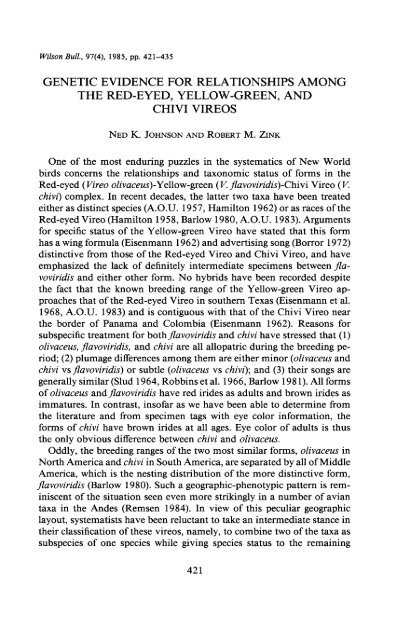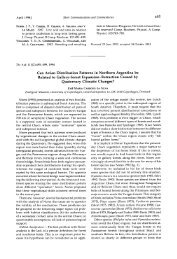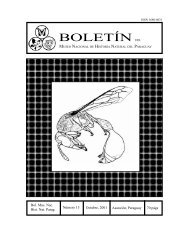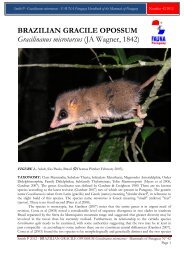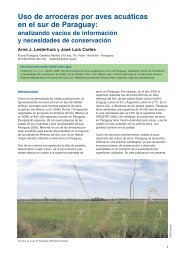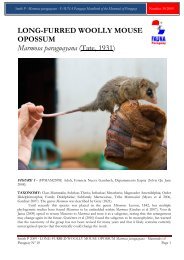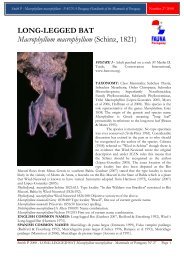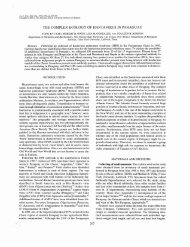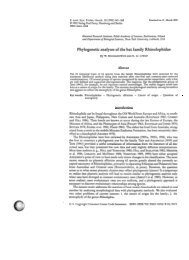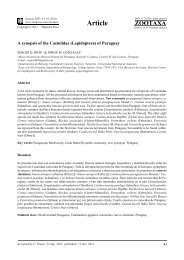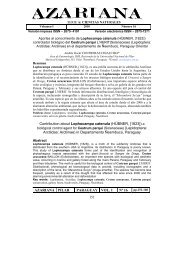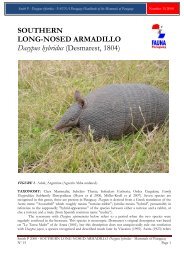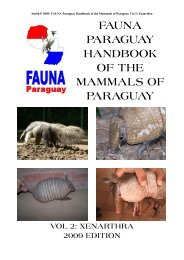Download pdf 838KB - FAUNA Paraguay
Download pdf 838KB - FAUNA Paraguay
Download pdf 838KB - FAUNA Paraguay
You also want an ePaper? Increase the reach of your titles
YUMPU automatically turns print PDFs into web optimized ePapers that Google loves.
Wilson Bull., 97(4), 1985, pp. 421-435<br />
GENETIC EVIDENCE FOR RELATIONSHIPS AMONG<br />
THE RED-EYED, YELLOW-GREEN, AND<br />
CHIVI VIREOS<br />
NED K. JOHNSON AND ROBERT M. ZINK<br />
One of the most enduring puzzles in the systematics of New World<br />
birds concerns the relationships and taxonomic status of forms in the<br />
Red-eyed (I%eo olivaceus)-Yellow-green (K Jlavoviridis)-Chivi Vireo (I’.<br />
chivi) complex. In recent decades, the latter two taxa have been treated<br />
either as distinct species (A.O.U. 195 7, Hamilton 1962) or as races of the<br />
Red-eyed Vireo (Hamilton 1958, Barlow 1980, A.O.U. 1983). Arguments<br />
for specific status of the Yellow-green Vireo have stated that this form<br />
has a wing formula (Eisenmann 1962) and advertising song (Borror 1972)<br />
distinctive from those of the Red-eyed Vireo and Chivi Vireo, and have<br />
emphasized the lack of definitely intermediate specimens between fla-<br />
voviridis and either other form. No hybrids have been recorded despite<br />
the fact that the known breeding range of the Yellow-green Vireo ap-<br />
proaches that of the Red-eyed Vireo in southern Texas (Eisenmann et al.<br />
1968, A.O.U. 1983) and is contiguous with that of the Chivi Vireo near<br />
the border of Panama and Colombia (Eisenmann 1962). Reasons for<br />
subspecific treatment for bothJlavoviridis and chivi have stressed that (1)<br />
olivuceus, fluvoviridis, and chivi are all allopatric during the breeding pe-<br />
riod; (2) plumage differences among them are either minor (olivuceus and<br />
chivi vsj7uvoviridis) or subtle (olivuceus vs chivi); and (3) their songs are<br />
generally similar (Slud 1964, Robbins et al. 1966, Barlow 198 1). All forms<br />
of olivuceus andflavoviridis have red irides as adults and brown irides as<br />
immatures. In contrast, insofar as we have been able to determine from<br />
the literature and from specimen tags with eye color information, the<br />
forms of chivi have brown irides at all ages. Eye color of adults is thus<br />
the only obvious difference between chivi and olivuceus.<br />
Oddly, the breeding ranges of the two most similar forms, olivuceus in<br />
North America and chivi in South America, are separated by all of Middle<br />
America, which is the nesting distribution of the more distinctive form,<br />
jkzvoviridis (Barlow 1980). Such a geographic-phenotypic pattern is rem-<br />
iniscent of the situation seen even more strikingly in a number of avian<br />
taxa in the Andes (Remsen 1984). In view of this peculiar geographic<br />
layout, systematists have been reluctant to take an intermediate stance in<br />
their classification of these vireos, namely, to combine two of the taxa as<br />
subspecies of one species while giving species status to the remaining<br />
421
422 THE WILSON BULLETIN l Vo’ol. 97, No. 4, December I985<br />
taxon. Nonetheless, the evidence on genetic differentiation presented here<br />
supports exactly such a position. We propose that the two geographically<br />
disjunct taxa, olivaceus and chivi, are conspecific but that the form that<br />
occurs between them, flavoviridis, deserves species rank. Although we<br />
studied only the subspecies diversus from <strong>Paraguay</strong>, all forms of the Chivi<br />
Vireo are considered here to be subspecies of the Red-eyed Vireo. Admittedly,<br />
eventual genetic study of the other geographic differentiates of<br />
chivi could provide results that might drastically alter this position.<br />
The genie data, considered together with the current breeding distributions<br />
of the taxa, also enable a more objective discussion of phyletic<br />
history than heretofore has been possible. Unfortunately, we lack genetic<br />
information from several other forms of the genus, including the Blackwhiskered<br />
Vireo (V. altiloquus), Yucatan Vireo (V. magister), and the<br />
Golden Vireo (k’. hypochryseus). Although some or all of these species<br />
are probably closely related to the k’. olivaceus-flavoviridis-chivi complex<br />
(Hamilton 1962, Barlow 1980) in the absence of data on genetic distances<br />
we do not consider them further in this paper.<br />
MATERIALS AND METHODS<br />
Our analysis is based on 17 specimens of the Red-eyed Vireo (K o. olivuceus), one<br />
specimen of the Yellow-green Vireo (V. f: flavoviridis), 14 specimens of the “Chivi” Vireo<br />
(V. o. diversus), and one specimen of the Rufous-browed Peppershrike (Cyclarhis gujanensis<br />
ochrocephalu). The latter form was used as an outgroup taxon.<br />
Samples of heart, liver, kidney, and pectoral muscle were removed from specimens l-4<br />
h after collection in the field, preserved in liquid nitrogen, then stored in Berkeley, California,<br />
at -76°C (Johnson et al. 1984). Tissue extracts were prepared for electrophoresis according<br />
to methods described by Selander et al. (1971). Gel and buffer combinations used were<br />
essentially those outlined by Yang and Patton (198 1). Thirty-eight presumptive genetic loci<br />
were scored. Although some loci were scored on more than one gel type, our basic approach<br />
was “one pass” (Aquadro and Avise 1982). Precise electrophoretic conditions are available<br />
from the authors. The most common allele at a locus was designated M; alleles with more<br />
anodal or cathodal migrations were coded as F or S, respectively. Further refinements in<br />
migratory position were coded with plus and minus signs.<br />
The distribution of observed and expected numbers of heterozygotes (Table l), over all<br />
loci in a sample, was tested for departure from Hardy-Weinberg expectation (Hart1 1981)<br />
with a x2 test (Barrowclough 1980). Individual heterozygosity was calculated by dividing<br />
the number of loci at which an individual was heterozygous by the total number of loci<br />
scored (38 for all birds). Two measures of average individual heterozygosity per population<br />
sample (Ho,_ and H.,,) were calculated as described in Johnson and Zink (1983:873).<br />
Individual genotypes were converted to allelic frequencies (Table 2) for each sample. Genetic<br />
distances between samples (Table 3) were computed using the methods of Nei (1978) and<br />
Rogers (1972). Branching diagrams depicting patterns of genie similarity among samples<br />
(Fig. 1) were constructed using the methods of Sneath and Sokal (1973; UPGMA and<br />
WPGMA phenograms), Farris (1972; distance Wagner tree, optimized according to Swofford<br />
[ 198 l]), and Fitch and Margoliash (1967; “F-M’ trees).
Johnson and Zink l GENETIC RELATIONSHIPS AMONG VIREOS 423<br />
TABLE 1<br />
GENETIC VARIABILITYMEASURESFOR FOUR TAXAOFVIREONIDAE<br />
Percent Average<br />
PolY- number<br />
morphic of<br />
TaXOIl N Sample areas H., k SE H.,. k SE locib all&S=<br />
V. 0. olivaceus 17 Minnesota (15) 0.059 + 0.014 0.054 k 0.017 39.47 1.53<br />
Oklahoma (2)<br />
V. o. diversus 14 SE <strong>Paraguay</strong> 0.060 + 0.016 0.065 2 0.025 26.32 1.47<br />
V. J jlavoviridis 1 Costa Rica 0.0 0.0 0.0 1.00<br />
C. ochro-<br />
g. SE <strong>Paraguay</strong> 0.053 0.026 5.26 1.03<br />
cephala 1<br />
Total 33<br />
Meand 0.057 0.036 17.76 1.26<br />
= Breeding specimens only. Exact localities can be obtained from the authors<br />
b Frequency of most common allele 50.99.<br />
c Per locus.<br />
d Unweighted by sample size.<br />
RESULTS<br />
Variation at loci and heterozygosity. -Of the 38 loci scored, 19 (50%)<br />
showed at least a single heterozygote. At five other loci, the species were<br />
fixed at alternative alleles. Therefore, 24 (63.2%) of the total loci were<br />
variable among the taxa examined. Allelic frequencies at the polymorphic<br />
loci are listed by taxon in Table 2. The 14 monomorphic loci, within and<br />
between taxa, were: LDH- 1, AB- 1, AB-2, AB-3, LAP, SOD- 1, EAP, GOT-<br />
1, GOT-2, MDH-1, MDH-2, GLUD (=GDH), ADH, and EST-l. Acronyms<br />
for enzymes follow Harris and Hopkinson (1976).<br />
The observed and expected heterozygosities, the percentage of polymorphic<br />
loci and the mean number of alleles per locus for the four taxa<br />
of vireonids treated are given in Table 1. The fact that we examined only<br />
a single individual each of V. Jflavoviridis and C. g. ochrocephala presents<br />
no problem in the estimation of either mean levels of heterozygosity or<br />
genetic distance. According to theoretical (Nei 1978) and empirical (Gorman<br />
and Renzi 1979) rationales, good estimates of these parameters can<br />
be obtained from single specimens, given that a relatively large number<br />
of loci is analyzed and that heterozygosity is relatively low.<br />
Values for observed heterozygosity for V. o. olivaceus and V. o. diversus<br />
were 0.059 and 0.060, respectively (Table 1). These values are somewhat<br />
higher than 0.048, the figure reported by Avise et al. (1982:97) for a large<br />
sample of V. olivaceus (presumably V. o. olivuceus), and 0.053, the average<br />
value reported for birds in general by Barrowclough (1983). In average
V. 0. olivaceus<br />
V. o. diversus<br />
V. f: jlavoviridis<br />
C. g. ochrocephala<br />
Johnson and Zink l GENETIC RELATIONSHIPS AMONG VIREOS 425<br />
TABLE 3<br />
MATRIX OF GENETIC DISTANCES BETWEEN FOUR TAXA OF VIREONIDAE~<br />
V. 0. olivaceus V. o. diversus y. f: Jlavovrridis C. g. ochrocephala<br />
- 0.014 0.177 0.533<br />
0.053 - 0.176 0.528<br />
0.188 0.182 - 0.495<br />
0.427 0.419 0.39 1 -<br />
a Nei’s (1978) D-values are above the diagonal and Rogers’ (1972) D-values are below the diagonal<br />
number of alleles per locus, I/. o. olivuceus and V. o. diversus were also<br />
very similar (1.53 vs 1.47, respectively). No genetic variation was detected<br />
in the single individual of I’. J flavoviridis. The specimen of Rufousbrowed<br />
Peppershrike had only two heterozygous loci (LA-l and ADA).<br />
The observed number of heterozygotes in both samples of the Red-eyed<br />
Vireo (sensu lato) did not differ from Hardy-Weinberg expectation: I’. o.<br />
olivaceus, x29 = 5.1; V. o. diversus, x2,O = 6.3.<br />
When the four taxa were compared at specific loci, several major differences<br />
were seen (Table 2). For example, l? jflavoviridis is apparently<br />
fixed at an allele which is different from the predominant one shared by<br />
I! o. olivuceus and I’. o. diversus, at GDA, EST-4, aGPD, GSR, PGM-2<br />
and CK-h. C. g. ochrocephala is apparently fixed at a unique allele at 13<br />
(54.2%) of the 24 variable loci: NP, CK, EST-4, aGPD, ALD, ADA, MPI,<br />
SDH, GPT, ME, ACON, LDH-h, and CK-h, indicating large differences<br />
between it and the forms of Vireo.<br />
Some differences in relative variability at particular loci were also evident.<br />
At both 6-PGD and ME, V. o. olivuceus had three alleles whereas<br />
V. o. diversus was fixed. At PGM-2, V. o. diversus showed four alleles<br />
whereas V. o. olivaceus had two. Furthermore, at that locus, the predominant<br />
allele was different in the two taxa. Otherwise, these two taxa,<br />
considered to be conspecific in this paper, are very similar in allelic frequency<br />
distributions.<br />
Genetic distances. -Rogers’ (1972) and Nei’s (1978) values for genetic<br />
distances among the four taxa treated are given in Table 3. K o. olivaceus<br />
and V. o. diversus are genetically very similar (Nei’s D = 0.014). On the<br />
other hand, both V. o. olivaceus and V. o. diversus are quite different<br />
from K f: jZavoviridis, and at a nearly identical level (D = 0.177 and<br />
0.176, respectively). The outgroup, C. g. ochrocephala, differed substantially<br />
(D = 0.5 19) from the three taxa of Vireo.<br />
Phenograms and phylogenetic trees. -Despite the continuing debate<br />
over the suitability of different methods of branching (see Farris 198 1
426 THE WILSON BULLETIN l Vol. 97, No. 4, December 1985<br />
contra Felsenstein 1984) for describing phylogenies, we find that they<br />
reveal structure in the genetic data and are helpful in “visualizing” genetic<br />
distances. Also, because of the differing assumptions of each technique<br />
(e.g., relative homogeneity of rates of allozymic change), different kinds<br />
of information are revealed. In the present study, great congruence of<br />
pattern was achieved. The UPGMA and WPGMA clustering procedures<br />
(Sneath and Sokal 1973) for example, yielded virtually identical results;<br />
therefore, only the former is illustrated (Fig. 1A). All diagrams clearly<br />
show the close alliance of V. olivaceus and V. “chivi,” the more distant<br />
attachment of V. Jlavoviridis as a sister group to the first pair of forms,<br />
and the great separation of C. gujanensis from the clade comprised of the<br />
three forms of Mreo. We feel confident, therefore, that the consistent<br />
pattern of branching achieved in these analyses was not a simple result<br />
of the methodology employed (Presch 1979). That is, the branching pat-<br />
tern was independent of assumptions regarding the nature of the data.<br />
DISCUSSION AND CONCLUSIONS<br />
Age of the Taxa<br />
Several researchers (e.g., Nei 1975, Sarich 1977, Yang and Patton 198 1,<br />
Gutierrez et al. 1983) have attempted to determine the absolute timing<br />
of cladogenetic events by various calibrations applied to Nei’s D values<br />
among existing species. Gutierrez et al. (1983) for example, used the mid-<br />
Miocene date of a fossil quail, Cyrtonyx cooki (Wetmore 1934), in con-<br />
junction with average genetic distances between modern Cyrtonyx mon-<br />
tezumae and its Odontophorine sister taxa, to derive a calibration value<br />
of t = 26.3 x 106D, where t is the time since divergence and D is Nei’s<br />
(1978) genetic distance. Such calibrations are dependent on the existence<br />
of a molecular clock (Wilson et al. 1977, Thorpe 1982), that is, a process<br />
by which nucleotide substitutions and, therefore, allelic differences among<br />
populations and species accumulate stochastically through mutation and<br />
drift in a uniform, time-dependent fashion. The recent finding of Bar-<br />
rowclough et al. (1985) that patterns of genetic divergence in diverse taxa<br />
of birds agree with the predictions of a neutral, mutation-drift process<br />
(Kimura 1979, 1982) lends credence both to the existence of a clock and<br />
to these dating attempts.<br />
Nonetheless, several problems attend the use of such calibrations: (1)<br />
the relative imprecision of the dating of most fossils, including that of<br />
the quail mentioned above; (2) the fact that large standard errors are<br />
usually associated with estimates of genetic distance; and (3) the typical<br />
lack of independent means, beyond general stratigraphic date or degree<br />
of morphologic change, by which to judge the validity of divergence times
Johnson and Zink l GENETIC RELATIONSHIPS AMONG VIREOS 427<br />
A. UPGMA rcc = 997 V 0 OlWaCeus(Red-eyed Vlreo)<br />
B.<br />
1 1<br />
042 036 030 0 24 0 18 0 12 006 0<br />
Rogers’ D<br />
150 46 d37 b<br />
WAGNER TREE % S.D. = 20.5<br />
C<br />
0 315<br />
Million years before present<br />
f<br />
i<br />
082<br />
076<br />
Vo d/versus (“Chivl” Vlreo)<br />
V flovovirid~s (Yellow-green V~reo)<br />
C q~,a”ens,s (Rufous-browed<br />
1<br />
V<br />
Pepper-Shrikel<br />
030 V 0 olivaceus<br />
023<br />
V o dtversus<br />
flu YO vk/d;s<br />
* C gqanensa<br />
1 I I , I I I I 1 1 I<br />
0 002 004 0.06 0.08 0.10 0.12 0.14 0.16 0.18 0.20<br />
C.<br />
F-M TREE<br />
% S D.= 187<br />
Distance from root<br />
FIG. 1. (A) Phenogram based on Rogers’ D-values (Table 3) and derived by the UPGMA<br />
method. The high cophenetic correlation coefficient (rcc = 0.977) indicates very close agree-<br />
ment between the distances shown in the phenogram and the original distance matrix. See<br />
text for the derivation and interpretation of the time scale. (B) Distance Wagner Tree rooted<br />
at the outgroup, Cyclarhis gujanensis. The F-value (Farris 1972) is 0.002 and the cophenetic<br />
correlation is 1.00. This analysis produced no negative branches. (C) Branching diagram<br />
derived by the method of Fitch and Margoliash (1967). Branch lengths are in units of Rogers’<br />
D (x 100). The tree is “rooted” (see Farris 1972) at Cyclurhis gujunensis. Of 6 F-M Trees<br />
examined, the one illustrated best summarized the original matrix based on the lack of<br />
negative branches and lowest percentage standard deviation.
428 THE WILSON BULLETIN l Vol. 97, No. 4, December 1985<br />
calculated in this manner. Despite these caveats, gross approximations<br />
of cladogenetic dates are useful because they offer a hypothetical frame-<br />
work within which possible phyletic history can be addressed. Without<br />
such estimates, one is left with the alternative of blind speculation.<br />
According to the calibration of Gutierrez et al. (1983), the Nei’s genetic<br />
distance of 0.495 between V. f: jlavoviridis and C. g. ochrocephala in-<br />
dicates that the ancestors of these two taxa split approximately 13 million<br />
years before the present (MYBP), or in the late Miocene (Fig. 1A). Sub-<br />
sequent separation of the lineage leading to IJ’. olivaceus-“chivi” from that<br />
leading to flavoviridis, which differ by a Nei’s D of 0.176, occurred at<br />
approximately 4.6 MYBP, in the late Pliocene. Finally, the small Nei’s<br />
D (0.014) recorded between K o. olivaceus and K o. diversus (=“chivi”)<br />
suggests that these taxa diverged comparatively recently, on the order of<br />
370,000 years ago, during the Pleistocene. The substantial, formally rec-<br />
ognized geographic variation of I? “chit? in South America (10 subspe-<br />
cies, Blake 1968) is in keeping with such a date.<br />
Avise et al. (1982) reported that congeneric vireos are separated by<br />
genetic distances that average considerably higher than those between<br />
congeneric species in other passerine families. On these grounds they<br />
suggested that speciation events in Vireo may have been older compared<br />
with those of other groups. Our finding of a relatively large genetic distance<br />
between jlavoviridis and both olivaceus and chivi provides corroboration<br />
of their result. We are currently examining the issue of increased genetic<br />
distances among vireos through the electrophoretic analysis of additional<br />
forms, including several species not studied by Avise et al. (1982).<br />
The substantial genetic distance between Cyclarhis and the members<br />
of Vireo is perhaps not surprising in view of the fact that the pepper-<br />
shrikes have often been considered on other grounds to represent either<br />
a distinct subfamily or a distinct family (Cyclarhidae) related to the Vir-<br />
eonidae. Based on evidence from DNA-DNA hybridization, however,<br />
Sibley and Ahlquist (1982) concluded that Vireo and Cyclarhis were sim-<br />
ilar enough to be placed in the same subfamily. This apparent disagree-<br />
ment between the data from electrophoresis and those from DNA-DNA<br />
hybridization cannot be resolved at present. But it is clear that any ex-<br />
planation proposed for the difference must take into account the unusually<br />
large genetic distances now known among vireos and their close relatives.<br />
Historical Biogeography of the Taxa<br />
The unambiguous genetic results permit evaluation of possible histor-<br />
ical biogeographic events that led to the observed geographic pattern.<br />
From many conceivable speculative scenarios, we depict four diagram-<br />
matically (Fig. 2). In these diagrams, the breeding range of the ancestral
Johnson and Zink l GENETIC RELATIONSHIPS AMONG VIREOS 429<br />
pre- ffav0viridis<br />
FIG. 2. Schematic representations of four hypothetical scenarios of the biogeographic<br />
history of Vireo olivacew, V. jlavoviridis, and V. “chivi” in North, Middle, and South<br />
America, respectively. See text for additional explanation.<br />
taxon is unpatterned, that of the first derivative taxon is single-hatched,<br />
and that of the most recently derived taxon is crosshatched. The first<br />
three scenarios (A-C) are dispersal models. These assume that the an-<br />
cestral taxon occupied part or all of one of the three current ranges and
430 THE WILSON BULLETIN l Vol. 97, No. 4, December 1985<br />
dispersed to and differentiated in the remaining two distributions after<br />
simple colonization followed by range expansion. The fourth scenario<br />
(D), a vicariance model, assumes that much or all of the present combined<br />
range of the three taxa was occupied by a common ancestor that occurred<br />
through North, Middle, and South America. Subsequent fragmentation<br />
of all or part of this ancestral distribution provided for the isolation<br />
necessary for the differentiation of olivaceus, jlavoviridis, and chivi.<br />
Many other more complex models, which involve either colonization or<br />
vicariance processes, admittedly are possible. Models that conceive of the<br />
origin of K flavoviridis in South America, with subsequent budding of K<br />
olivaceus and I/. chivi, are also plausible. None of these more intricate<br />
models is considered here in detail because in our view one of the simple<br />
models presented in Fig. 2 adequately explains the observed data.<br />
Scenario A. -This phylogenetic hypothesis proposes that pre-Jlavovir-<br />
idis or flavoviridis was ancestral and originated in Middle America. It<br />
gave rise to olivaceus, which, in turn, spawned chivi through leapfrog fall<br />
migration over the centrally located taxon. Presumably, chivi arose through<br />
colonization of South America by wintering individuals of olivaceus that<br />
failed to return to their breeding grounds. This scenario (1) is in agreement<br />
with the morphologic and genetic distinctiveness offlavoviridis compared<br />
with the similarity of olivaceus and chivi; (2) implicates the present mi-<br />
gratory patterns as possible clues to phyletic events; (3) permits the an-<br />
cestral taxon, flavoviridis, to occupy an intermediate “refuge-position”<br />
during late Pliocene-Pleistocene climatic refrigeration; (4) allows colonists<br />
from pre-flavoviridis to establish olivaceus as habitats became available<br />
to the north after glaciation; and (5) is in keeping with a Middle American<br />
center of diversification for the Vireonidae, as suggested by Hamilton<br />
(1962, but see Cracraft 1973:5 18). Furthermore, this hypothesis does not<br />
require us to invoke rapid evolutionary rates in flavoviridis, versus more<br />
moderate rates of change in olivaceus and chivi, to account for the greater<br />
phenetic-genetic differences of the former taxon.<br />
Vireo flavoviridis is also migratory, with populations moving between<br />
the breeding grounds in Mexico and Middle America and the wintering<br />
regions in Amazonia. Morton (1977) has suggested that both the present<br />
scheduling of annual movement and the ultimate selective reason for the<br />
evolution of migration in this vireo are related to the seasonal scarcity of<br />
fruit in the nesting region. Whatever the reason, the fact of migration in<br />
this species in no way reduces the likelihood of Scenario A; a nesting<br />
population of either pre-I’. flavoviridis or of I’. Jlavoviridis presumably<br />
would have provided the stock that eventually budded off the ancestors<br />
of I’. olivaceus to the north.<br />
Scenario B.-This scenario resembles the one depicted in Fig. 2A in
Johnson and Zink l GENETIC RELATIONSHIPS AMONG VIREOS 431<br />
that it suggests a stepwise origin of the two derivative taxa, olivaceus and<br />
chivi, from ancestralflavovirid. In this scenario, however, colonists leading<br />
to chivi budded off first; these then gave rise to olivaceus by a northward<br />
leapfrog movement over jlavoviridis. The fact that southern populations<br />
of chivi are presently migratory and move north in the late austral summer<br />
perhaps provided in the past the possibility for migratory overshoot by<br />
groups that became established north offlavoviridis and then evolved into<br />
olivaceus. Several tropical or subtropical species with migratory populations<br />
in the Southern Hemisphere (e.g., Fork-tailed Flycatcher [Muscivora<br />
tyrannus] and Tropical Kingbird [Tyrannus melancholicus]) currently are<br />
vagrant to North America (National Geographic Society 1983) and provide<br />
examples of such migratory overshoot.<br />
Scenario C. -This scenario assumes that both olivaceus and chivi arose<br />
independently, and in essentially the same span of time, from ancestral<br />
jlavoviridis. The improbability that separate groups of colonists fromflavoviridis,<br />
moving northward and southward, respectively, would by chance<br />
be nearly identical genetically, however, renders this suggestion unlikely.<br />
Scenario D. -This scheme derives modem jlavoviridis, olivaceus, and<br />
chivi from an extensive and continuous range that underwent fragmentation.<br />
In this model, migration evolved in the various isolated taxa after<br />
their initial split. This scenario also requires more rapid evolution in the<br />
component that led to flavoviridis, than in the sections that evolved into<br />
olivaceus and chivi, to account for the greater genetic and phenetic differences<br />
of the former taxon. The degree to which the invocation of rapid<br />
evolution presents a problem is debatable. On the one hand, it is welldocumented<br />
that differences in morphology and coloration in birds can<br />
evolve quickly (Johnston and Selander 1964, 197 1). On the other hand,<br />
rapid genetic change seems less likely, especially in view of the findings<br />
of Barrowclough et al. (1985).<br />
Although any of these schemes is plausible, we prefer Scenario A. It is<br />
simple because it does not require the added assumption of differing<br />
evolutionary rates of genes among the three taxa, and, most importantly,<br />
is realistic. Modem populations of olivaceus migrate annually to Amazonia<br />
to spend the winter. These wintering hordes of olivaceus in South<br />
America could have provided abundant opportunity in the past for the<br />
establishment of breeding colonies that evolved into chivi. Members of<br />
the chivi group in South America have brown irides, a feature shared by<br />
immatures of I’. o. olivaceus. This fact suggests that the developmental<br />
pathway leading to red irides in adult V. o. olivaceus was switched off<br />
during the differentiation of the stock that led to chivi. Brown eyes in<br />
adults of the latter taxon may be thought of, therefore, as a paedomorphic<br />
character. Welty (1982:554) cites examples of colonization and establish-
432 THE WILSON BULLETIN l Vol. 97, No. 4, December 1985<br />
ment by wintering individuals of other species, thus our suggestion of this<br />
phenomenon in vireos is not novel.<br />
Barlow (1980:103) speculated on the origin and phyletic history of<br />
“proto- Vireosylva” and one of its branches, the “ V. olivaceus subspecies<br />
complex.” He proposed that the proto-Vireosylva lineage originated in<br />
Middle America and subsequently sent a segment into South America in<br />
the late Tertiary. There it diversified and eventually gave rise to progen-<br />
itors of the V. olivaceus group. Early representatives of the V. olivaceus<br />
complex then spread northward in waves, into the Caribbean through the<br />
Lesser Antilles and from the mainland of Middle America, leaving proto-<br />
V. magister and V. altiloquus, and continued into North America. Al-<br />
though Barlow does not hypothesize details of branching of forms in the<br />
V. olivaceus subspecies complex, we interpret his scenario to imply that<br />
the South American representative (V. “chivi”) is oldest, the Middle<br />
American form (K flavoviridis) is of intermediate age, and the North<br />
American component (I’. olivaceus sensu stricto) is youngest.<br />
The new genetic data offered here, however, do not support Barlow’s<br />
suggested phyletic history of the V. olivaceus group. Instead of being<br />
intermediate in age, V. flavoviridis, based on its significant genetic differ-<br />
ences, is probably the oldest of the three taxa. We feel that the steady,<br />
time-dependent accumulation of more allelic changes in V. Jlavoviridis<br />
than in V. “chivi” and V. olivaceus verifies the greater age of the former<br />
taxon. We emphasize, however, that despite our reliance on a genetic<br />
explanation, we still are presenting only a partial analysis of branching<br />
patterns in this complex of Vireo. A complete understanding of phylo-<br />
genesis in V. olivaceus and its relatives will be possible only when elec-<br />
trophoretic data for V. altiloquus, V. magister, and perhaps other forms<br />
are available for comparison.<br />
SUMMARY<br />
Using starch gel electrophoresis, we assessed genetic distances among<br />
samples of the Red-eyed Vireo (Vireo olivaceus), the Yellow-green Vireo<br />
(V./‘.avoviridis), and the “Chivi” Vireo (V. “chivi”). Tissues from a Rufous-<br />
browed Peppershrike (Cyclarhis gujanensis ochrocephala) provided an<br />
outgroup comparison. The three complexes of Vireo have been treated<br />
in the past either as a single species or as three separate species.<br />
Thirty-eight genetic loci were scored. The Red-eyed and “Chivi” vireos<br />
are very similar genetically (Nei’s D = 0.0 14). In contrast, these two forms<br />
differ strikingly from the Yellow-green Vireo (Nei’s D = 0.177 and 0.176,<br />
respectively). Several branching methods (UPGMA, WPGMA, Wagner<br />
Tree and F-M Tree) gave congruent results on relationships. These data<br />
support the position that the Red-eyed and “Chivi” vireos are conspecific.<br />
The Yellow-green Vireo, however, clearly deserves full species status.
Johnson and Zink l GENETIC RELATIONSHIPS AMONG VIREOS 433<br />
The genie data suggest that the clade leading to Vireo olivaceus-flavoviridis-“chivi”<br />
split from Cyclarhis at approximately 13 MYBP. Ensuing<br />
separation of V. Jlavoviridis from V. olivaceus-“chivi” occurred at about<br />
4.6 MYBP. The division of North American K olivaceus from its South<br />
American relatives in the “chivi” complex occurred approximately 370,000<br />
years ago, during the Pleistocene. We speculate that “chivi” arose from<br />
wintering individuals of V. olivaceus that failed to return to North America.<br />
ACKNOWLEDGMENTS<br />
We are especially grateful to J. A. Marten, who performed the electrophoretic analysis<br />
and assisted with computations. M. Frelow ran the program for the construction of the<br />
Fitch-Margoliash (“F-M”) tree. G. F. Barrowclough sponsored and led the field trip to Costa<br />
Rica on which the specimen of Yellow-green Vireo was taken. Specimens from <strong>Paraguay</strong><br />
were taken under a permit kindly issued by Ing. H. Bertoni, Minister of Agriculture. A. and<br />
M. Reynaers and Sr. and Sra. H. Beckers graciously allowed us to work on their property<br />
in <strong>Paraguay</strong>. M. S. Foster and R. E. Jones assisted in the collection of specimens. V. Remsen<br />
and the students in the Avian Biology (“Bird Bunch”) Seminar, University of California,<br />
Berkeley, provided helpful discussion of phylogenetic-distributional aspects of the problem.<br />
Two reviewers, J. C. Avise and J. C. Barlow, offered valuable comments. G. M. Christman<br />
prepared the final version of the figures. Ms. B. Resnick typed the manuscript. The work<br />
was funded by National Science Foundation Grant DEB 79-09807 and an Annie M. Alex-<br />
ander Grant from the Museum of Vertebrate Zoology to the first author.<br />
LITERATURE CITED<br />
AMERICAN ORNITHOLOGISTS’ UNION. 1957. Check-list of North American birds, 5th ed.<br />
Am. Omithol. Union, Baltimore, Maryland.<br />
-. 1983. Check-list of North American birds, 6th ed. Am. Omithol. Union, Wash-<br />
ington, D.C.<br />
AQUADRO, C. F. AND J. C. AVISE. 1982. Evolutionary genetics of birds. VI. A reexamination<br />
of protein divergence using varied electrophoretic conditions. Evolution 36: 1003-10 19.<br />
AVISE, J. C., C. F. AQUADRO, AND J. C. PATTON. 1982. Evolutionary genetics of birds. V.<br />
Genetic distances within Mimidae (Mimic Thrushes) and Vireonidae (Vireos). Biochem.<br />
Genet. 20:95-104.<br />
BARLOW, J. C. 1980. Patterns of ecological interactions among migrant and resident vireos<br />
on the wintering grounds. Pp. 79-107 in Migrant birds in the Neotropics: ecology,<br />
behavior, distribution, and conservation (A. Keast and E. S. Morton, eds). Smithson.<br />
Inst. Press, Washington, D.C.<br />
-. 198 1. Songs of the vireos and their allies. Ara Records, No. 7, Gainesville, Florida.<br />
BARROWCLOUGH, G. F. 1980. Genetic and phenotypic differentiation in a wood warbler<br />
(Genus Dendroica) hybrid zone. Auk 97:655-668.<br />
-. 1983. Biochemical studies of microevolutionary processes. Pp. 223-261 in Per-<br />
spectives in ornithology (A. H. Brush and G. A. Clark, Jr., eds). Cambridge Univ. Press,<br />
Cambridge, England.<br />
- N. K. JOHNSON, AND R. M. ZINK. 1985. On the nature of genie variation in birds.<br />
Pp. 135-l 54 in Current ornithology, Vol. 2 (R. F. Johnston, ed.). Plenum Publ. Corp.,<br />
New York, New York.<br />
BLAKE, E. R. 1968. Family Vireonidae. Pp. 103-138 in Check-list of birds of the World<br />
(R. A. Paynter, Jr., ed.). Museum of Comparative Zoology, Cambridge, Massachusetts.
434 THE WILSON BULLETIN l Vol. 97, No. 4, December I985<br />
BORROR, D. J. 1972. Yellow-green Vireo in Arizona, with notes on vireo songs. Condor<br />
74:80-86.<br />
CRACRA~, J. 1973. Continental drift, paleoclimatology, and the evolution and biogeog-<br />
raphy of birds. J. Zool. Lond. 169:455-545.<br />
EISENMANN, E. 1962. Notes on some Neotropical vireos in Panama. Condor 64:505-508.<br />
-, J. I. RICHARDSON, AND G. I. CHILD. 1968. Yellow-green Vireo collected in Texas.<br />
Wilson Bull. 80:235.<br />
FARRIS, J. S. 1972. Estimating phylogenetic trees from distance matrices. Am. Nat. 106:<br />
645-668.<br />
-. 198 1. Distance data in phylogenetic analysis. Pp. 3-23 in Advances in cladistics,<br />
Vol. 1 (V. A. Funk and D. R. Brooks, eds.). Ann. N.Y. Bot. Gardens, New York, New<br />
York.<br />
FELSENSTEIN, J. 1984. Distance methods for inferring phylogenies: A justification. Evo-<br />
lution 38: 16-24.<br />
FITCH, W. M. AND E. MARGOLIASH. 1967. Construction ofphylogenetic trees. Science 155:<br />
279-284.<br />
GORMAN, G. C. AND J. RENZI, JR. 1979. Genetic distance and heterozygosity estimates in<br />
electrophoretic studies: effects of sample size. Copeia 1979:242-249.<br />
GUTIERREZ, R. J., R. M. ZINK, AND S. Y. YANG. 1983. Genie variation, systematic, and<br />
biogeographic relationships of some galliform birds. Auk 100:33-47.<br />
HAMILTON, T. H., 1958. Adaptive variation in the genus Vireo. Wilson Bull. 70:307-346.<br />
-. 1962. Species relationships and adaptations for sympatry in the avian genus Vireo.<br />
Condor 64:40-68.<br />
HARRIS, H. AND D. A. HOPKINSON. 1976. Handbook of enzyme electrophoresis in human<br />
genetics. North-Holland Publ. Co., Amsterdam, Netherlands.<br />
HARTL, D. L. 1981. A primer of population genetics. Sinauer Assoc., Inc., Sunderland,<br />
Massachusetts.<br />
JOHNSON, N. K. AND R. M. ZINK. 1983. Speciation in sapsuckers (Sphyrupicus): I. Genetic<br />
differentiation. Auk 100:871-884.<br />
-, R. M. ZINK, G. F. BARROWCLOUGH, AND J. A. MARTEN. 1984. Suggested techniques<br />
for modem avian systematics. Wilson Bull. 96:543-560.<br />
JOHNSTON, R. F. AND R. K. !&LANDER. 1964. House sparrows: rapid evolution of races in<br />
North America. Science 144:548-550.<br />
-. 197 1. Evolution of the house sparrow. II. Adaptive differentiation in North Amer-<br />
ican populations. Evolution 25:1-28.<br />
KIMURA, M. 1979. The neutral theory of molecular evolution. Sci. Am. 24 1:98-l 26.<br />
-. 1982. The neutral theory as a basis for understanding the mechanism of evolution<br />
and variation at the molecular level. Pp. 3-56 in Molecular evolution, protein poly-<br />
morphism and the neutral theory (M. Kimura, ed.). Japan Scientific Societies Press,<br />
Tokyo, Japan.<br />
MORTON, E. S. 1977. Intratropical migration in the Yellow-green Vireo and Piratic Fly-<br />
catcher. Auk 94:97-106.<br />
NATIONAL GEOGRAPHIC SOCIETY. 1983. Field guide to the birds of North America. National<br />
Geographic Society, Washington, D.C.<br />
NEI, M. 1975. Molecular population genetics and evolution. North Holland Publ. Co.,<br />
Amsterdam, Netherlands.<br />
-. 1978. Estimation of average heterozygosity and genetic distance from a small<br />
number of individuals. Genetics 89:583-590.<br />
PRESCH, W. 1979. Phenetic analysis of a single data set: phylogenetic implications. Syst.<br />
Zool. 28:366-371.
Johnson and Zink l GENETIC RELATIONSHIPS AMONG VIREOS 435<br />
REMSEN, J. V., JR. 1984. High incidence of “leapfrog” pattern of geographic variation in<br />
Andean Birds: implication for the speciation process. Science 224: 17 l-l 73.<br />
ROBBINS, C. S., B. BRUUN, AND H. S. ZIM. 1966. Birds of North America. Golden Press,<br />
New York, New York.<br />
ROGERS, J. S. 1972. Measures of genetic similarity and genetic distance. Univ. Texas Publ.<br />
7213:145-153.<br />
SARICH, V. M. 1977. Rates, sample sizes, and the neutrality hypothesis for electrophoresis<br />
in evolutionary studies. Nature 265:24-28.<br />
SELANDER, R. K., M. H. SMITH, S. Y. YANG, W. E. JOHNSON, AND J. B. GENTRY. 197 1.<br />
Biochemical polymorphism and systematics in the genus Peromyscus. I. Variation in<br />
the old-field mouse (Peromyscus polionotus). Univ. Texas Publ. 7 103:49-90.<br />
SIBLEY, C. G. AND J. E. AHLQUIST. 1982. The relationships of the vireos (Vireoninae) as<br />
indicated by DNA-DNA hybridization. Wilson Bull. 94: 114-l 28.<br />
SLUD, P. 1964. The birds of Costa Rica. Bull. Am. Mus. Nat. Hist. 128: l-430.<br />
SNEATH, P. H. A. AND R. R. SOKAL. 1973. Numerical taxonomy. W. H. Freeman and Co.,<br />
San Francisco, California.<br />
SWOF~ORD, D. L. 198 1. Utility of the distance Wagner procedure. Pp. 25-44 in Advances<br />
in cladistics, Vol. 1 (V. A. Funk and D. R. Brooks, eds.). Ann. N.Y. Bot. Gardens, New<br />
York, New York.<br />
THORPE, J. P. 1982. The molecular clock hypothesis: biochemical evolution, genetic differentiation<br />
and systematics. Ann. Rev. Ecol. Syst. 13:139-168.<br />
WELTY, J. C. 1982. The life of birds, Third ed. Saunders, Philadelphia, Pennsylvania.<br />
WETMORE, A. 1934. A fossil quail from Nebraska. Condor 36:30.<br />
WILSON, A. C., S. S. CARLSON, AND T. J. WHITE. 1977. Biochemical evolution. Ann. Rev.<br />
Biochem. 46:573-639.<br />
YANG, S. Y. AND J. L. PATTON. 198 1. Genie variability and differentiation in the Galapagos<br />
finches. Auk 98230-242.<br />
MUSEUM OF VERTEBRATE ZOOLOGY AND DEPT. ZOOLOGY, UNIV. CALIFORNIA,<br />
BERKELEY, CALIFORNIA 94720. (PRESENT ADDRESS OF RMZ: MUSEUM OF<br />
ZOOLOGY, LOUISIANA STATE UNIV., BATON ROUGE, LOUISIANA 70803.)<br />
ACCEPTED 8 AUG. 1985.<br />
COLOR PLATE<br />
The Frontispiece painting of Tanguru meyerdeschauenseei has been made possible by an<br />
endowment established by George Miksch Sutton (1896-1982). The painting is by J. P.<br />
O’Neill.


